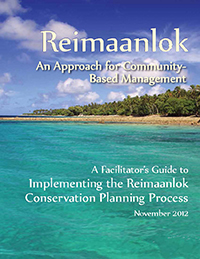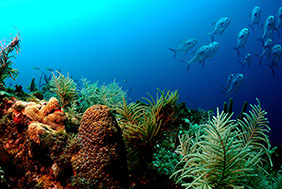-
Home
-
Data & Publications
-
Regional Portals
- About Regional Portals
- Florida
- Navassa Island
- Puerto Rico
- Flower Garden Banks
- U.S. Virgin Islands
- American Samoa
- Commonwealth of the Northern Mariana Islands
- Federated States of Micronesia
- Guam
- Main Hawaiian Islands
- Republic of the Marshall Islands
- Northwestern Hawaiian Islands
- Republic of Palau
- Pacific Remote Island Areas
-
CRCP Activities
- Glossary
Republic of the Marshall Islands
The Republic of the Marshall Islands is a collection of 1,225 islands and islets of which only five are single islands. The rest are grouped into 29 coral atolls and five solitary low coral islands, which together make up more than 10 percent of all the atolls in the world. They lie in two parallel chains known as sunrise (Ratak) and sunset (Ralik). They are narrow and low and encircle large central lagoon.
The Marshall Islands are spread out over an exclusive economic zone of nearly 1 million square miles. It is one of only four atoll nations in the world and is also one of the world’s youngest nations, independent since 1986. Majuro atoll, capital of the Marshall Islands, is the most developed atoll with a thriving commercial and political center and a population of nearly 30,000. The Marshall’s Kwajalein Atoll is the largest atoll in the world.
In general, the reefs of the Marshall Islands are in good condition and have experienced minimal damage from bleaching, destructive fishing techniques, and sedimentation. Even those in the former nuclear test sites have shown remarkable recovery. However, there is some evidence of unsustainable resource exploitation. For example, the largest giant clams have been harvested and the current take of grouper, reef shark, and Napoleon wrasse may not be sustainable. The reefs near the urban areas of Majuro are stressed, but still have an abundance of fishes and invertebrates. Localized outbreaks of crown-of-thorns starfish, Acanthaster planci, and coral disease were observed around Majuro in 2005.

Republic of the Marshall Islands satellite map
Highlights
Facilitator's Guide to Implementing the Reimaanlok Conservation Planning Process

The Field Guide was developed to fill the need for a conservation area planning framework and "develop principles, process, and guidelines for the design, establishment, and management of conservation areas that are fully owned, led, and endorsed by local communities based on their needs, values, and cultural heritage." This step-by-step guide includes management tools and examples that will help facilitators establish resource management plans and community-based conservation areas that consider current and future trends (including climate change), locally and globally, that affect the islands' resources and their sustainability. The Guide is published and available online at: https://library.oarcloud.noaa.gov/noaa_documents.lib/Sea_Grant_documents/Hawaii/UNIHI-SEAGRANT-BB-12-01.pdf.
Publications
Majuro Atoll, Republic of the Marshall Islands Coral Reef Ecosystems Mapping Report - NOAA Technical Memorandum NOS NCCOS 144
SEM-Pasifika Workshop report, Republic of the Marshall Islands May 4-9, 2008
Coral reef biodiversity community-based assessment and conservation planning in the Marshall Islands: baseline surveys, capacity building and natural protection and management of coral reefs of the atoll of Rongelap (RALgov public report - 2002)
Coral reef biodiversity community-based assessment and conservation planning in the Marshall Islands: Baseline surveys, capacity building and natural protection and management of coral reefs of the atolls of Rongelap and Mili. Final Report to National Fishery and Wildlife Foundation - 2003
Pacific Islands Water Science Center Publications - Republic of the Marshall Islands
Facilitator's Guide to Implementing the Reimaanlok Conservation Planning Process
State of The Reefs Report (SOTR)
The State of Coral Reef Ecosystems of the United States and Pacific Freely Associated States: 2008.
The State of Coral Reef Ecosystems of the United States and Pacific Freely Associated States: 2005.
The State of Coral Reef Ecosystems of the United States and Pacific Freely Associated States: 2002.
Management Activities
Bikirin Island Conservation and Restoration Plan
Metadata, Data and Publications Search in CoRIS
Search the CoRIS Geoportal for Marshall Islands metadata, data and publications, or enter the name of any of its components, such as "Kwajalein Atoll", in the CoRIS Geoportal search box and press the "Search" button.
ReefBase Coral Bleaching Reports
Select “Micronesia” in the Region window and “Marshall Islands” in the Country window
Near-real-time Data
Coral Reef Watch Satellite Monitoring
Coral Reef Watch - Marshall Islands Virtual Stations
The Global Temperature-Salinity Profile Program
NOAA CO-OPS - Tide Data
NOAA Tidal Predictions - Marshall Islands
National Weather Service
- Pacific Region Headquarters
- National Weather Service Office - Majuro
- Marshall Islands - Current Weather Conditions
National Data Buoy Center - Western Pacific Recent Marine Data
Other Data
Benthic Habitat Mapping of Majuro, Republic of the Marshall Islands
- Atlas of the Shallow-Water Benthic Habitats of Majuro Atoll, Republic of the Marshall Islands - NOAA Technical Memorandum NOS NCCOS 153
- GIS Map Files
- Majuro BioMapper - Interactive mapping tool for exploring maps, satellite images, and field data
GIS Map of Mosaiced LandSat 7 ETM+ Satellite Imagery of the Republic of the Marshall Islands
Key Documents
Executive orders, Secretarial Orders, and Congressional Acts
Micronesia Coral Reef Initiative
Education and Outreach
Embassy of the Republic of the Marshall Islands
BBC News: Country Profile. Republic of the Marshall Islands
CIA World Fact Book – Marshall Islands
U.S. Department of State Background Note
Marshall Islands - General Historical and Contemporary Information
Marine Protected Areas/Marine Managed Areas
Marine Protected Areas of the United States Home Page
The Marine Protected Areas Inventory
Marine Federal Areas Fact Sheet


